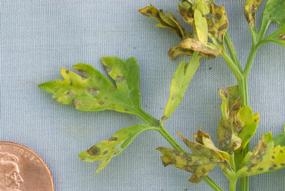
California parsley is produced typically in high volumes and with high quality. However in the past few years, growers began to observe unfamiliar disease issues in their parsley fields. Leaf spots, blighted foliage and yellowed plants contributed to loss of quality and reduced yields. Steven Koike and Oleg Daugovish, UC Cooperative Extension advisors in Monterey and Ventura counties respectively, stepped in to investigate the new parsley problems. They collaborated with farmers and pest control advisers to understand the extent of the problems and to obtain samples of the diseased crops.
The UC Cooperative Extension plant pathology diagnostic lab in Salinas was successful in isolating and identifying several pathogens that were responsible for causing the disease symptoms. Working with USDA, they found that three new diseases were present in California parsley crops: bacterial leaf spot, Stemphylium leaf spot, and Apium virus Y disease.
Two of these problems are seedborne, so future management will include the use of pathogen-free seeds. The Apium virus Y pathogen is found in weeds, so growers will need to remove poison hemlock, among others.
Previous to this research, some growers were spraying symptomatic fields because they believed that a disease called late blight was responsible for the disease symptoms. Growers have now ceased making these sprays, eliminating the use of unnecessary chemicals and saving costs.
